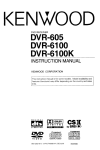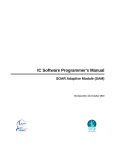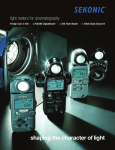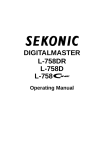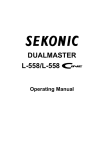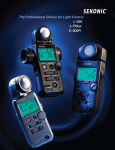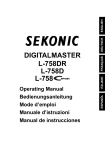Download Sekonic MULTIMASTER L-408 Operating instructions
Transcript
EXPOSURE METER 8 Operating Instructions SAFETY PRECAUTIONS This manual uses the following safety labels fork WARNING andA CAUTION that you must follow. &, Indicates hazards or unsafe practices that can result in severe personal injury or death. WARNING n CAUTION Indicates hazards or unsafe practices that can result in the personal injury or a damage to your L-408 exposure meter. Indicates an operation note or limitation you must use. Please read the notes to avoid an incorrect L-408 operation. Provides the reference information and related functions that are useful for your L-408 operations. + Store your L-408 in a safe place so that a little child cannot take 8 it and not to wind the strap around his/her neck. Q) Never drop dry cells in a fire. Also, do not jumper, disassemble, or overheat the dry cells. If done, the cells may explode and you may be injured or the ambient may be contaminated. A CAUTION I i 0 To avoid injury to your eyes, never look at the sun through the viewfinder. 8 To avoid an electrical shock, never plug in or remove the syncro cord when water drops, the moisture is too high, or your hands are wet. FEATURES Thank you for your purchase of the Sekonic Multimaster L-408. It features: 1. Built-in non-parallax viewfinder with 5 degree acceptance angle. 0 Built-in viewfinder eliminates parallax error caused by separate viewfinders. l Built-in design eliminates troublesome viewfinder mounting and removal in the field. 2. Unique, new combination of Lumisphere and Lumidisc. l l 3. All operations directly on meter body. Reduces workload, speeds operation and removes risk of losing accessories. Fast and accurate light balancing reading because the unit features an exclusive, retracting Lumisphere which allows fast, accurate light balancing readings, while eliminating the need for additional accessories. Water-resistant. l The first photographic apparatus that has the water-resistant construction. Stands up to dirty, sooty, damp industrial locations and wet weather, outdoors. 4. Aperture or shutter speed priority. ID Aperture or shutter speed priority can be selected according to choice. Both modes are available for ambient light reading. 5. Memory function is useful for subject contrast measurement, 0 The three memory values are displayed on the LCD analog scale to provide simple balancing of light and subject contrasts. 6. Multiple flash measurement. 0 When a single flash is insufficient to illuminate a subject, repeated flash exposures on the same film frame or sheet of film will build exposure to the correct level and the cumulative effect of these exposures can be accurately measured by the meter. ii CONTENTS i SAFETY PRECAUTIONS .......................................................... ii FEATURES ................................................................................ 1 Parts Designations .............................................................. 2 :: Display ............................................................................... 2 2-1 LCD panel ............................................................................... 4 2-2 Light-receiving indicator .......................................................... 4 .................... 2-3 Viewfinder information ........................................ 5 3 . Mode Selection ................................................................... 5 3-1 Switching between lumisphere UP and DOWN positions ...... 5 3-2 Switching between incident and reflected light metering ........ 6 4 . Light-receiving Method ........................................................ 4-1 Incident light metering (with eyepiece cover closed) ............ 6 6 4-2 Reflected light metering (with eyepiece cover open) ............... 7 5 . Preparation for Measurement ............................................. 7 5-1 Mounting a type-AA battery ................................................... .......... 7 5-2 Battery check ................................................................ 8 5-3 Auto Power OFF ...................................................................... 8 5-4 ISO film speed setup ............................................................... 8 .......................... 5-5 Light-receiving method setup ...................... 9 5-6 Measurement mode setup ...................................................... 10 5-7 Shutter speed priority setup ................................................... 10 5-8 Aperture priority setup ........................................................... 11 6 . Ambient Light Measurement .............................................. 11 6-1 Mode selection ...................................................................... 11 6-2 Measuring switch ................................................................... 11 6-3 Shutter speed priority setup ................................................... 11 6-4 Measurement ......................................................................... 12 6-5 Data memory ......................................................................... 13 6-6 Contrast measurement .......................................................... 7. Flash Measurement with Cord ................................................... 14 14 7-1 Single flash measurement ..................................................... 15 7-2 Data memory ......................................................................... 15 7-3 Cumulative flash measurement ............................................. 16 7-4 Contrast measurement .......................................................... 17 8. Flash Measurement without Cord .............................................. 17 8-1 Single flash metering ............................................................. 18 8-2 Data memory ......................................................................... 18 8-3 Cumulative measurement ...................................................... 19 8-4 Contrast measurement .......................................................... 20 9 . Other Metering Operations ................................................ 20 9-1 Exposure index correction .................................................... 21 9-2 Using your L-408 as an illumination meter ........................... 21 9-3 Using your L-408 as a luminance meter ................................ 22 Specifications .................................................................... 23 Instructions and Maintenance Notes ................................. 1. Parts Designations Light-receiving indicator- _ ____ Objective lens cover POWER switch receiving element) Measuring switch UP/DOWN button display (LCD) panel Mode selector F/EV/MULTI selector ’ Synchro terminal Viewfinder Eye-piece cover Memory button Battery case cover lock 1 2. Display .~ 2.1 LCD panel @ Mode selection m Ambient light measurement Flash measurement without cord Flash measurement with cord The mode symbols are switched in the following sequence: @ Aperture/EV/Battery/Others “b.c” Battery capacity 2‘:“; See Page 7. Aperture value (Indicated by a number and dots 2’:‘i ) See Page 11. Aperture-priority measurement Exposure value (Indicated by a number and dots $:‘$ ) See Page 11. Eu Under exposure Eo Over exposure - I - The mark flashes during Reflected Light Metering. See Page 6. One full stop is shown by 9 bars. A single bar indicates one tenth stop. 2 @ m Number of cumulative flashes When the flash is fired, this mark appears and the measurement times are acccumulated. More than 10 measurement causes the “E” (error) mark to appear. See Pages 15 and 18. IS0 film speed The film speed of IS0 3 to 8000 is shown. See Page 8. 0 Measuring-level adjustment This mark appears when the measuring-level adjustment is carried out. See Page 20. @ @ T Shutter speed or film frame count (F. P. S.) (?J M Shutter speed in minutes Q Shutter speed in seconds m Number of frames per second R~J Shown during exposure index correction. See Page 20. Analog display 2 Underexposure ; Overexposure e I. Aperture (A bar or dot indicates 0.5 stop.) The analog display can be switched to memory dot display using the memory function. See Page 12. 2.2 Light-receiving indicator Slide the eyepiece cover up or down to set metering to either incident light or reflected light (with 5-degree viewfinder metering). Light receiving indicator ‘... -1 Incident light metering Reflected light metering 2.3 Viewfinder information Circle e) indicates 5 degree spot measurement. Center spot @ is for positioning of spot measurement. Viewfinder information 4 3. Mode Selection Your L-408 can measure both incident and reflected light in both ambient light and flash (strobe or bulb) modes. You can switch the modes as follows: [LighM~fng [Llghk$\mg [Measured light) IMl speed priority measurement (Can be stored in memory)i ) See Page 11 Exposure priority measurement (Cannot be stored in memory) 3.1 ‘ 1 Switching between incident metering and reflected light metering (with 5-degree viewfinder metering) Slide the eyepiece cover closed for incident light metering, or open the eyepiece cover for reflected light metering. Incident light metering (with cover closed) Caution I Reflected light metering (with cover open) Set the eyepiece cover at the top or button click position only. Otherwise, the LCD markings (entire display) will blink and you cannot start metering with the measuring switch. 3.2 Switching between lumisphere up and down positions Manually rotate the lumisphere UP/DOWN ring counterclockwise to move the lumisphere up. You can now start incident light metering. Rotate the ring clockwise to retract the lumisphere for balancing light metering. Lumisphere up position @6%$ Lumisphere down position Set the lumisphere UP/DOWN ring to one of the dot marked positions. Any other position will result in incorrect metering. L , 5 4. Light-receiving Method Incident light metering (with eyepiece cover closed) 4.1 Hold the L-408 close to the subject, point the lumisphere towards the camera, and measure the incident light intensity. .\; q Lumisphere in up position: For incident measurement Lumisphere in down position: For light balance and simple illuminance eflected light metering (with eyepiece cover open) Your L-408 has a built-in viewfinder. By sliding the eyepiece cover down to its open position, you can use it as a 5-degree spot meter for accurate spot metering. Hold the L-408 at your camera position, and place the circle in the viewfinder on the target subject. @@%I + Spot metering under 50 cm (20 inches) is not possible. NOTE * When you open the eyepiece cover, 141 appears in the light-receiving indicator and _ i _ flashes in the bar display area. r 5. Preparation for Measurement 5.1 Mounting a battery and strapping Use a 1.5volt, type-AA (UM3 dry, LR-6 or R-6) battery. Do not use a NiCd battery. @ Unlock the cover lock and remove the battery case cover. @ Insert the battery in the battery case aligning the polarities as indicated on the inside of the case. @ insert the claws of the cover into the holes of the , Pull down the strap ring. bodv. Lock the cover lock. Battery case cover Cover lock Attaching the strap Remove the battery case cover. (3 Move the cover lock toward the battery case (arrow a). a Pass the strap through strap eyelet 0. @ Pass the opposite side of the strap through a strap ring. ICAUTION 1 l To save your current setup, turn the POWER switch OFF first, then replace the battery. e If the LCD message is abnormal or if nothing occures when you press an operation button, remove the battery. Wait at least 10 seconds. Then, mount the battery (in the correct polarity) and try again. l Wipe and clean the rubber seal of battery cover. Sand and dust may cause water leakage, corrosion or other problems. 5.2 Battery check Turn the POWER switch on, and the LCD panel (“b.c” message and bar marking 2‘:“; ) displays the current battery level. The battery level is indicated by a number of bars for one second. Then, the LCD panel automatically switches to the normal measurement mode. NOTES 0 You can sustain battery level display by holding down the Power switch. * When the battery capacity drops below the limit, the “b.c” display blinks and then goes out. * When the battery level is indicated by only two or three dots, replace the battery. 5.3 Auto Power-off To save battery capacity, the L-408 is automatically turned off (and all readings are erased) 10 minutes after your last operation. .~ NOTE @ When the L-408 is automatically turned off by Auto Power-off, settings (such as mode selection, exposure setup and measured values) are saved. They are displayed again when the POWER switch is turned on. - 5.4 IS0 film speed setup Hold down the IS0 button (@iJ) and press the UP or DOWN button (c=@) to set the IS0 film speed. The UP button is used to select higher film speed, and the DOWN button for more than one second continuously increases or decreases the film speed. - NOTE /e You can also change the IS0 film speed after taking measurement. - The new calculated value is displayed when the film speed is changed after taking the measurement. 5.5 Light-receiving method setup Select incident light metering (with lumisphere in the UP or DOWN position) or reflected tight metering (with 5-degree spot meter). Eyepiece \ cover Closed Q 8 Incident light metering (with cover closed) Open 3 Eyepiece cover / Reflected light metering (with cover open) 5.6 Measurement mode setup Press the mode selection button (&iJ) to select the desired measurement mode. Mode switching sequence: ,+ ❂ Ambient Flash measurement Flash measurement --) w with cord without cord light + measurement I The following shows the meter display of each selected mode. ❂ (Ambient liqht measurement) mode: Press the F/EV/MULTI button (~0) to switch the display. Display switching sequence: + 6 Shutter speed + m Exposure value + i Aperture priority ._____ priority metering metering metering 1 ~~~~o;;~s;1’ I 14 2 28 4 ib 8 II 13?:3:f-6490 Shutter speed priority metering Exposure value metering Aperture priority metering (Flash measurement without cord) mode, and [Flash measurement with cord) mode Press the F/EV/MULTI button to select single or cumulative flash measurement. NOTES i l l Use single flash measurement when a single flash is sufficient. Use cumulative measurement when multiple flashes are needed (one to nine times.) Ten or more flashes are not possible, Single flash measurement i LiiiL’Ld.,,ti/?iL:il3ri i *li5lib: ,, lo‘2>il’t”4, 1 1 Cumulative measurement 1 I‘ / /a 4 c. E 1 i ‘I 3‘4 ?i ‘6 Flash measurement without cord J [ cl<-4 bi 1 Ire_ /‘ctes- J Flash measurement with cord 9 5.7 Shutter speed priority setup Press the UP/DOWN button (~=a) to select a shutter speed. The UP button is used to increase shutter speed, and the DOWN button to decrease it. Holding down the UP or DOWN button continuously increases or decreases the shutter speed. When the DOWN button is pressed once ; ;4 2 ;& 3 56 i i! 162232C:E4 93 5.8 Aperture priority setup Press the UP/DOWN button to set the desired aperture for aperture-priority measurement in ambient light. The UP button is used to decrease the aperture, and the DOWN button to increase it. Holding either button down continuously changes aperture. When the DOWN button is pressed once pJ m-- :;‘c \+ gJ -EJg IL% i-I When the UP button is pressed once 10 6. Ambient Light Measurement 6.1 Mode selection Press the mode selection button (c==@) to select the a Ambient light measurement mode. Shutter priority measurement 6.2 Measuring switch Press the F/EV/MULTI button (e=@) to select the desired measuring value display. EV exposure value measurement Exposure priority measurement After this measurement, you can change the measuring mode by pressing the F/EV/ MULTI button. NOTE e The EV (exposure value) shows light value based on the combination of shutter speed and aperture. 6.3 Shutter speed priority setup Press the UP or DOWN button to set the desired shutter speed. * Your L-408 covers shutter speeds from 30 minutes to 1/8000 sec. After NOTE 1/8000 sec. , the shutter speed of 1/200 and 1/400 sec. appears in the display, then from 8 to 128 frames per second (f/s) for cine speeds can be set. 6.4 Measurement Press the measuring switch (*a) to start measurement. Shutter speed priority measurement is set at "T:1/ 125” and “F:2.8+3/10”. U 1 14 2 2.8 4 56 8 11 1622324154 90 Exposure Value measurement is set at “EV10.3”. 11 Aperture priority measurement is set at “F:5.6+3/10” and “T: 1/30". i @iJ “3:’ El is r- Ii D -1 rr --1 .ar-1 z 3 1_ 3 !J NOTES * Bars and analog values are displayed. @ Ambient light metering continues as long as you keep pressing the measuring switch. 0 When you change the film speed, the measurement is recalculated and a new value is displayed. @ When the measuring range is exceeded, [ “Eu” (underexposure) or “Eo” ;a r:: G /3r (overexposure) appears. If "Eu" b.cL ’ - IL 3 appears, slow down the shutter speed or i 1~1.1.1.1.1.1.1.,~,.,~,..., open the aperture. If “Eo” appears, increase the shutter speed or close the aperture. 1 1.4 2 2.8 t 4 5.6 8 11 16 22 32 45 64 90 0 6.5 Data memory In the ambient light mode, you can store up to three aperture values at shutter speed priority measurements in memory. After measurement, press the memory button (@c=). The aperture value will be displayed on the analog scale with ( l or 1). You can store up to three measurements. The fourth measurement is displayed but not stored. You can store three measurements for each lightreceiving method. (See page 13 (5). So, a total of 9 measurements can be stored in memory. When measuring and storing data with the lumisphere in the DOWN position, your L-408 does not display the values measured with the lumisphere in the UP position or in the reflected light metering mode, To recall these measurements, switch the mode to lumisphere UP position or reflected light metering. To clear the memory, press the Clear Memory button. fI I m * The Clear Memory button clears all 9 measurements from the memory . 12 (3 Measurement mode/light-receiving method and memory Measuring mode R b c Ambient light Flash with cord Flash without cord Memory data count Light-receiving method lncldent light metering Reflected light metering Lvorphu. UP L-e (in the ambient light mode, memo; can be syored only in shu;ter priority measurement.) Caution You can only recall memory data in the same measuring mode. If you change the measuring mode, previous data is cleared from memory. 6.6 Contrast measurement To measure the contrast between the main and auxiliary light sources, set the lumisphere to the DOWN position. Then proceed as follows for shutter speed priority measurement: a Hold your L-408 close to the subject and point the lumisphere toward the main light source (turn the auxiliary light source off). Take reading. ia Press the Memory button to store the measured data in memory. @ Keep holding the L-408 close to the subject and point the lumisphere to ward the auxiliary light source (turn the main light source off). @ Compare the difference in brightness between the main and auxiliary light sources, and determine the contrast. * The contrast can be determined easily NOTE Example: The main light source is :b 2 1 _ and auxiliary light source is $c$ _ f - -,-A_u~p&w&~ 1 14 2 28 4 56 8*1116*22324564 9 0 Since the difference is two exposure increments, the contrast is 4:1. NOTE * To determine the correct exposure, turn both the main and auxiliary light sources on, point the lumisphere (UP position) toward the camera lens, and measure the exposure. 13 7. Flash Measurement with cord 7.1 Single flash measurement (II Flash measurement with cord (Flash measurement with cord) e mode selection button (e(Q)* 0 Never use the L-408 in flash mode when your hands are wet in conditions such as rain, splashing water or wet place. High voltage at the synchro terminal may result in an electric shock. Use the synchro terminal cap and select the flash without cord mode for safety. * The flash unit may “pop” when you connect the synchro cord to the L408 terminal or when you operate the POWER switch. * When using a flash bulb, check the synchro speed of the camera you use. Measurement with a flash bulb cannot be made in the flash cordless mode. Synchro cord connection Plug the flash synchro cord into the L-408 synchro terminal. Single flash measurement Select the single flash measurement mode using the F/EV/MULTI button (e@). @ Shutter speed setup Set the desired shutter speed using the UP/DOWN button (e@). NoTE @ Measurement Press the measuring switch (=a). The flash will fire and the correct aperture will appear on the LCD panel. I 14 8.1.8.8.848.8* 1 14 2 2.8 4 56 8 11 1622324564 30 1 NOTES l l l l If the camera’s flash does not fire, use flash measurement without cord. When the IS0 setup is changed, the measurement data is recalculated and redisplayed. If the shutter speed is changed after measurement, the measurement is lost and the aperture is cleared to zero (0). When the measuring range is exceeded, “Eu” (underexposure) or “Eo” (overexposure) appears. Correct the shutter speed or the light source. * Synchro cord (optional): A 5-meter-long synchro cord with three plugs is available for synchronous metering between your L-408 and the flash unit or between the camera and the flash unit. It is very convenient as no cord replacement is required during shooting pictures. The L408 is also equipped with a connector terminal lock for securing cable connection. light 7.2 Data memory In the single flash measurement mode, up to three measurements can be stored in memory. Memory storage is same as for the ambient light measurement (see 6.5 of Page 12). 7.3 Cumulative flash measurement @ Flash measurement with cord Select the (Flash measurement with cord) mode using the mode selection button (~=a). @J Cumulative flash measurement Select the cumulative flash measurement mode using the F/EV/MULTI button (G@). @ Shutter speed setup Set the desired shutter speed using the UP/DOWN button (=@). NOTE @ l --_l In this mode, you can set the shutter speed from 1 sec to 1/500 sec. After 1/500 sec., 1/75,1/80, 1/90, 1/100, 1/200 and 1/400 sec. appear in the display and you can select a particular shutter speed. _ --_ -._ / Measurement Press the measuring switch (=@). The flash will fire, and the aperture will appear on the LCD panel. Also! the cumulative aperture of each measurement and the number of accumulated flashes also appear. When a single flash firing is measured When four flash firings are measured ra : ii j-jIT j /J$:‘- re 5 I~l*l*l.l*I*l*l.~* 1 1 4 2 2 8 4 E6 8 111622324564 90 @ To cancel the Cumulative mode, just press the F/EV/MULTI button, To restart metering with new setup, press the F/EV/MULTI button. NOTES e When the IS0 setup is changed, the measurement data is recalculated and redisplayed. * If the shutter speed is changed after measurement, the measurement is lost and both the number of accumulated flashes and aperture are cleared to zero (0). 7.4 Contrast measurement The contrast measurement is the same as for ambient light measurement (see 6.6 of Page 13). 16 8. Flash Measurement without cord 8.1 Single flash metering <jr! Flash measurement without cord (Flash measurement without cord) mode using the mode selection button. @I Single flash measurement Select the single flash measurement mode using the F/EV/MULTI button. (3 Shutter speed setup Set the desired shutter speed using the UP/DOWN button. NOTE Cj> + In this mode, you can set the shutter speed from 1 sec to 1/500 sec. After 1/500 sec., 1/75, 1/80, 1/90, 1/100, 1/200 and 1/400 sec. appear in the display and you can select a particular shutter speed. Measurement Press the measuring switch. The mark will appear and your L-408 is ready to measure (Standby mode). When the flash fires, your L-408 displays the correct exposure. mark continues to blink and your L-408 NOTES * After this measurement, the remains in standby mode. 0 The standby mode continues for approximately 90 seconds and you can measure again within this time. If the mark goes out after 90 seconds press the measuring switch again. * When you change the film speed, the measurement is recalculated and a new correct value is displayed. l If the flash is NOT metered by your L-408 (when the flash is dimmer than the ambient light), use flash measurement with cord. @ If the shutter speed is changed after measurement, the measurement is lost and the aperture is cleared to zero (0). NOTES e When the measuring range is exceeded, “Eu” (underexposure) or “Eo” (overexposure) appears. Correct the shutter speed or the light source. @ If a rapid start luminescent lamp or special illumination lamp is to be measured (although no flash fires), connect the synchro cord and use the flash measurement with cord. 8.2 Data memory In the single flash measurement mode, up to three measurements can be stored in memory. Memory storage is the same as for ambient light measurement (see 6.5 of Page 12). 8.3 Cumulative measurement (i’/ Flash measurement without cord Select the (Flash measurement without cord) mode using the mode selection button (+a). @ Cumulative measurement Select the flash cumulative measurement mode using the F/EV/MULTI button (&)). @ Shutter speed setup shutter speed using the UP/DOWN NOTESet the desired , ,) ) ) ) button (&)). + In this mode, you can set the shutter speed from 1 sec to 1/500 sec. After 1/ 500 sec 1/75, 1/80, 1/90, 1/100, 1/200 and 1/400 sec. appear in the display and you can select a particular shutter speed. @ Measurement Press the measuring switch. The mark continues blinking and your L-408 enters the standby mode. 18 a- imom I’;2 / I \’ I 174 , -- i ICJ Ia w:f 1 1.4 2 2.8 4 Ei 5 11162232C64 30 i ~_ When the flash fires, the aperture value will appear on the LCD panel. The cumulative exposure of each measurement and the number of flashes also appear. ii ,-,When a single flash firing is measured b‘ 0 rj j iJ/J$‘- d c 3 /, ,.e..r,.l*.*l. 1 1.4 2 2.8 4 5.6 8 11 ’ 162?324564d When four flash firings are measured ( *.,.,*,.,..*..,.,* 1 1.4 2 2.8 4 5.6 8 11 16 22 32 45 64 90 ~3 To cancel Cumulative mode, just press the FEV/MULTI button. To restart metering with new setup, press the F/EV/MULTI button. mark continues to blink and your L-408 NOTES @ After this measurement, the remains in standby mode. 0 The standby mode continues for approximately 90 seconds. 8 If the flash is NOT metered by your L-408 (when the flash is dimmer than the ambient light), use flash measurement with cord. * If the shutter speed is changed after measurement, the measurement is lost and the exposure is cleared to zero (0). l If a rapid start luminescent lamp or special illumination lamp light is to be measured (although no flash fires), use flash measurement with cord. * No flash bulb measurement is supported. Use the synchro cord instead. 8.4 Contrast measurement Contrast measurement is the same as for ambient light measurement (see Step 6.6 of Page 13). 19 9.1 Exposure index correction Although your L-408 has been calibrated to exacting standards, you can manually correct the exposure within B.9 EV. @ Hold down the IS0 button (@a) and press the F/EV/MULTI button (~=a) to change display. Use the UP/DOWN button (e@) for exposure index correction. mark continues until the exposure index correction is canceled. q 1g-,-y;; ~ ii 0 The UP button increases the exposure index 0.1 step at a time (the exposure is reduced), while the DOWN button decreases the value (the exposure is increased). Holding down the button continuously increases or decreases the exposure index. (3j To cancel exposure index correction, hold down the UP/DOWN button until the exposure value reaches zero (0). The mark goes out. NOTES @ Determine the exposure index values after a sufficient number of tests in actual photographic conditions. 0 All of the measured values are corrected simultaneously according to the above correction regardless of the metering mode selected such as incident or reflected light measurement, and ambient or flash measurement. ---___-- --1_1-I --____-- - - - - 20 9.2 Using your L-408 as an illuminance meter @ Set your L-408 to the incident light and ambient light metering mode, and select the IS0 100 and EV display (turn off exposure index correction ). @ Set the lumisphere to the DOWN position, hold the L-408 parallel to the subject, and start metering. @ Determine the brightness level using the following conversion table or by calculation. I? EV-to-Lux conversion table Display example: EV9 2‘: _ @ Calculation Brightness level (Lx) = 2.5x2 EV = 2.5x2 9.4 = 2.5x724 = Approx. 1800 Lx 9.3 Using your L-408 as a luminance meter (0 Set your L-408 to the reflected light and ambient light metering mode, and select the IS0 100 and EV display (turn off exposure index correction ). Q; Measure the object using the viewfinder. i-3;) Determine the luminance level using the foliowing conversion table or by calculation. ti EV-to-cd/m2 conversion table Display example: EV9 21: _ a t-$Cl the conversion @ Calculation Luminance level (cd/m2) = 0.125x2 EV = 0.125x2 4.5 = 0.125x724 = Approx. 90 cd/m2 21 10. Specifications Type Light-receiving method Light-receiving section Light receiving element Metering systems Measuring range (IS0 100) Repeat accuracy Calibration constant Display range Other function Battery used Operating temperature range Storage temperature range Dimensions Weight Standard accessories * Digital exposure meter for ambient and flash metering * Incident and reflected light metering system * Incident light: Lumisphere /Flat diffuser function (Lumisphere down position) Built-in viewfinder (with 5-degree spot meter); 50 cm to l Reflected light: unlimited metering range l Silicon photo diode 0 Ambient light: Aperture-priority metering Shutter speed-priority metering * Flash light: With synchro cord Without synchro cord EV-1 to EV19.9 (in 0.1 step) l Ambient light: Incident light Reflected light EV2.5 to EV22.9 (in 0.1 step) Incident light F1.0 to F90 +0.9 stop (in 0.1 step) l Flash: F2.0 +0.5 stop to F90 +0.9 stop (in 0.1 step) Reflected light k09.1 EV or less C=340 (lumisphere), C=250 (Flat diffuser 0 Incident light metering: function/lumisphere DOWN) * Reflected light metering: K=12.5 * IS0 (film speed): 3 to 8000 (at 1/3 SV) * T (shutter speed): Ambient light: 30 min to 1/800 sec (in 1 sec step) plus 1/200 or 1/400 f/s (frames/sec): 8, 12, 16, 24, 25, 30, 32, 64, 128 Opening angle: 180 degrees Flash: 1 sec to 1/500 sec (at 1 TV) plus 1/75, 1/80, 1/90, 1/100, 1/200 or 1/400 l Aperture: 1.0 to 90.9 (in 0.1 step) - 9.9 to 36.1 (in 0.1 step) @ EV (Exposure Value): @ Analog display: F1.0 to 90 (in 0.5 step) 0 Water-resistant construction: JIS Class 4 @ Data memory function: Up to 9 readings (3 with lumisphere, 3 with flat diffuser/lumisphere DOWN, and 3 reflected light readings) can be stored in memory. l Cumulative function: Up to 9 flash readings can be accumulated. * Out-of-range metering: “Eu” (underexposure) or “Eo” (overexposure) alarm indication @ Exposure index correction: 3.9 EV 0 Battery check l Auto power-off l A single type-AA battery (UM3 dry, L-6 or LR-6), 1.5 V 0 -10°C to +50°C * -20°C to +60°C l l l Approx. 77Wx144Hx41D mm Approx. 180 g (without battery) Soft case, strap, synchro terminal cap, AA battery The specifications and appearance of the L-408 are subject to change without notice due to improvement. 22 11. Instructions and aintenance CAUTION IB Your L-408 exposure meter is water-resistant, but it is NOT water-proof. Do not wash your L-408 with water, and do not use it in water. i Water splash Rain ~i DO not wash with a water. Do not use in a water. @ To avoid damaging the exposure meter, never drop it or subject it to impact. @ Avoid keeping the exposure meter in places of high temperature or humidity. b Avoid excessive temperature changes, otherwise, condensation will occur, resulting in malfunction. MAINTENANCE NOTES a If your L-408 is splashed with water, immediately wipe it with a soft and dry cloth. Water leakage could cause corrosion or system malfunction. @ Avoid applying excessive force to the rubber seal of the battery case cover, Also, do not attempt to remove the rubber seal, otherwise, water invasion, corrosion or malfunction will result. e If the rubber seal is scratched or damaged, water invasion, corrosion or malfunction will result. Consult the dealer where the L-408 was purchased if this occurs. * Keep the surfaces of the lumisphere, lens and objective cover clean and free from dust, foreign particles and scratches. * Wipe off dirt with a soft or silicon cloth. Never use solvent such as thinner or benzine. 23



























